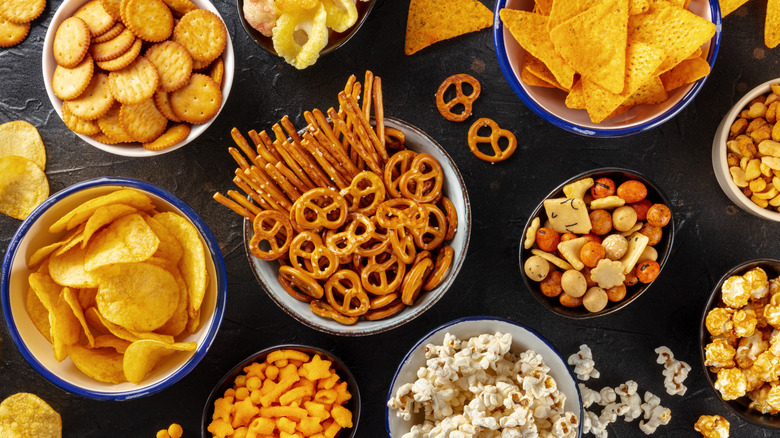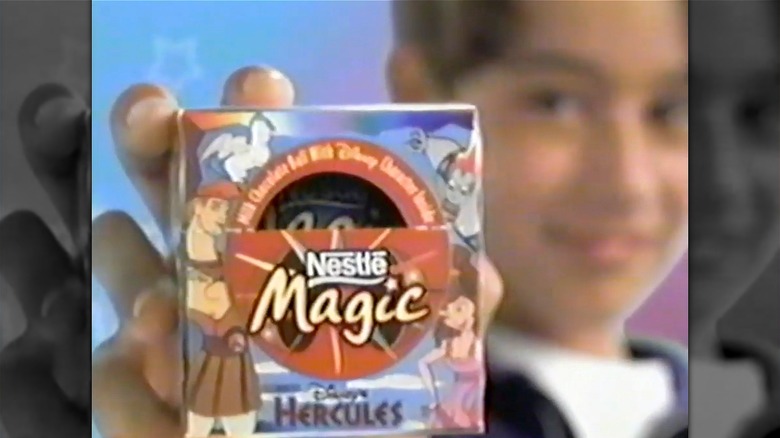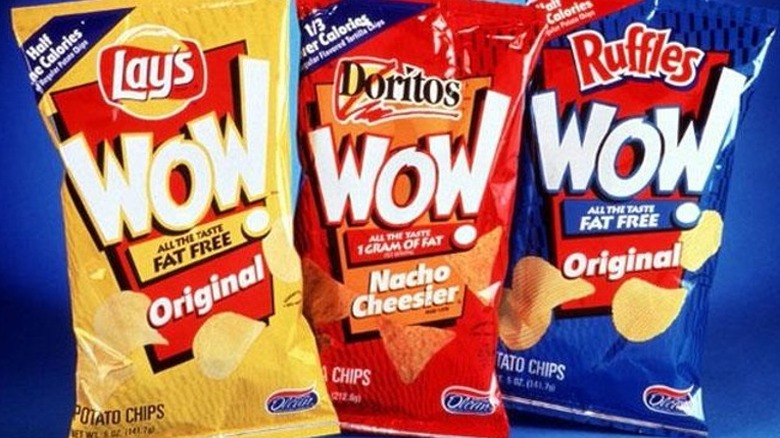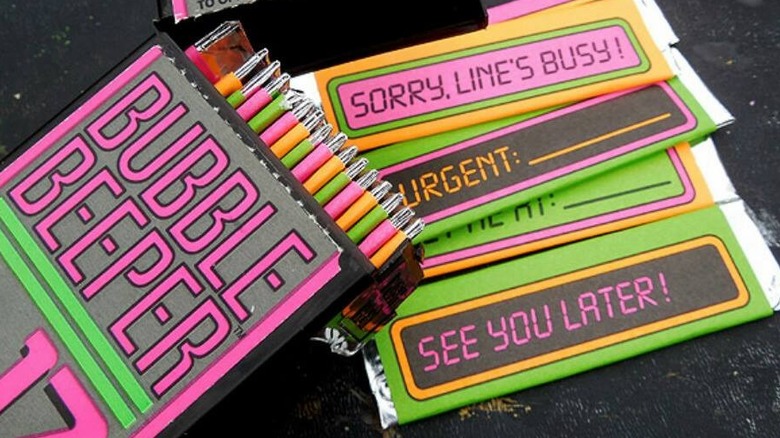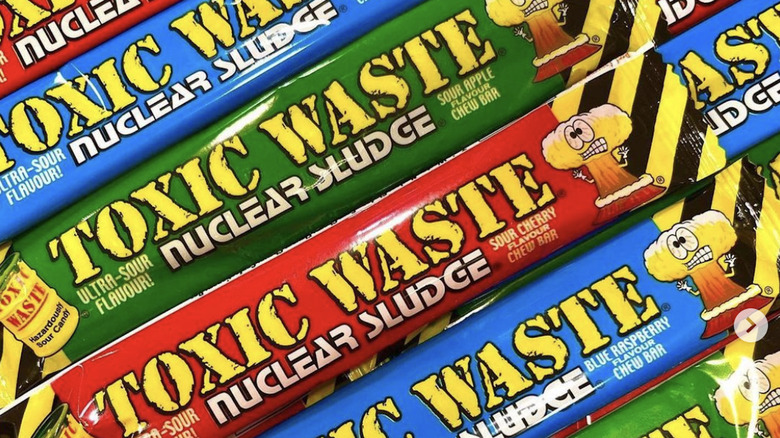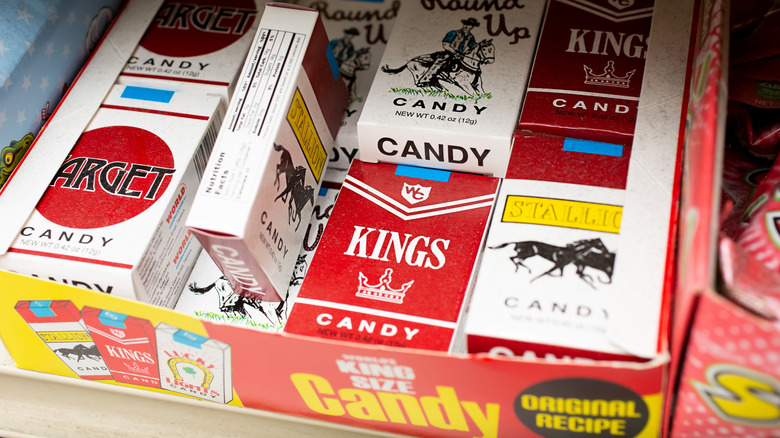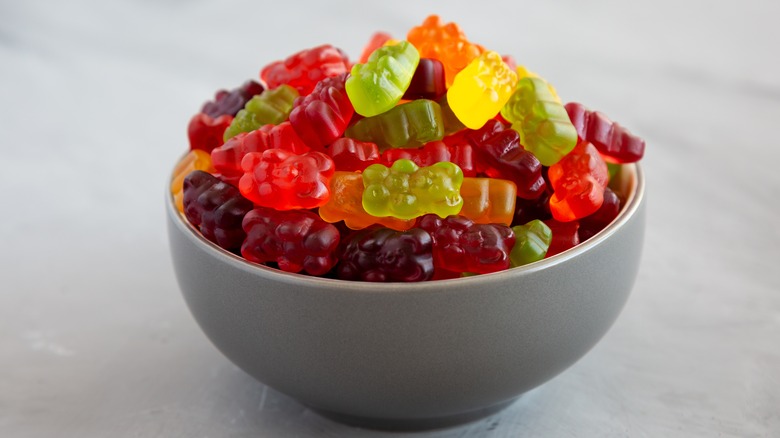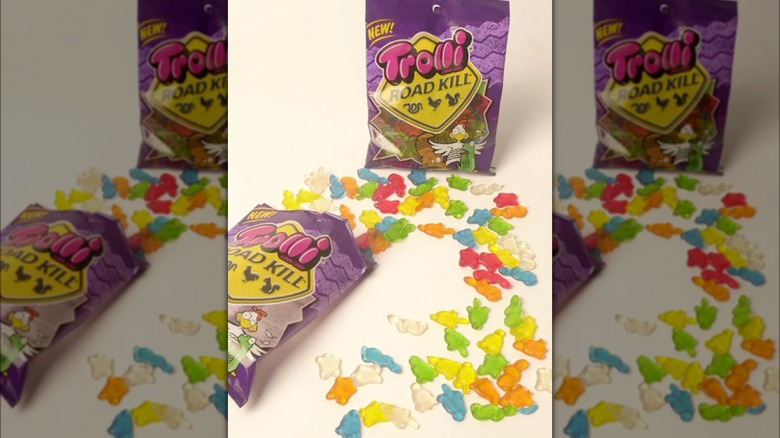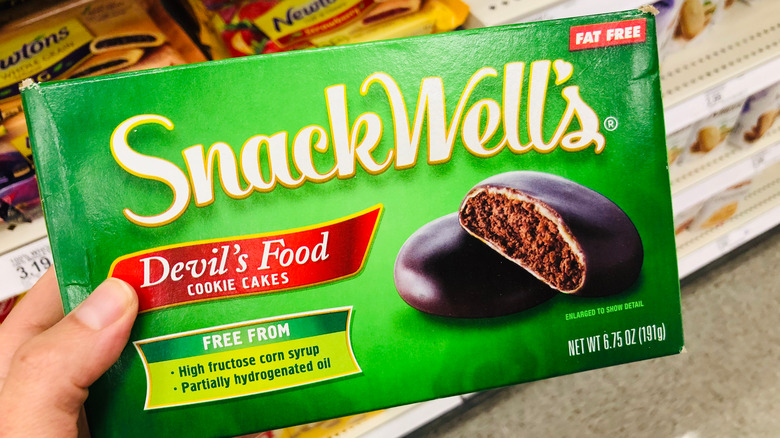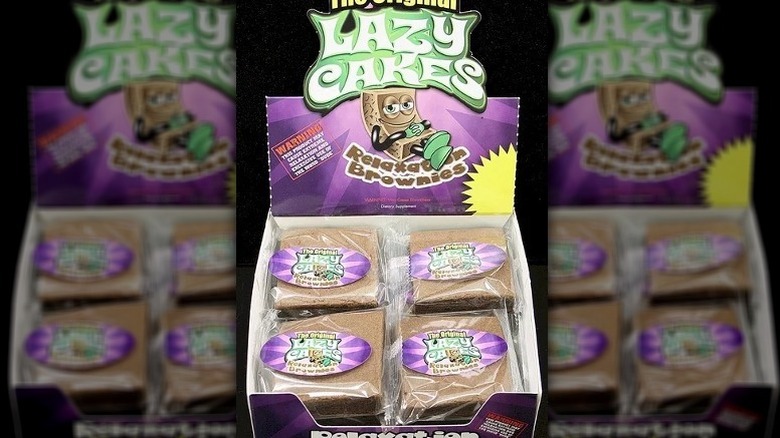9 Snack Food Products That Were Discontinued For Good Reason
We may receive a commission on purchases made from links.
You only have to glance around the grocery store to know that we live in a golden age of snack foods. Even with so many munchable products on the shelves, though, we still get a little nostalgic for the snacks of days gone by. While many snack food products from the 1990s and early '00s have stood the test of time — and changing consumer tastes — some have vanished from shelves completely and are unlikely to return.
Sometimes, snack foods get pulled from stores because customers don't like them. At the same time, some suffer an unfortunate fate, like when Trader Joe's patio potato chips were discontinued because of a fire at the production plant. Other times, well, let's just say that sometimes food companies have a good reason for discontinuing certain product lines. From disastrous diet foods to downright deadly candy, these retro snack foods are (probably) gone for good.
Nestlé Magic chocolate balls were considered a choking hazard
Candy and a toy rolled into one, Nestlé Magic chocolate balls were, on paper, the perfect treat for kids. Released in the 1990s, Nestlé Magic balls played on the widespread popularity of kids' TV by encasing plastic figurines of beloved Disney characters inside edible candy shells as part of the Disney renaissance (1989 to 1999). The Nestlé Magic chocolate balls were essentially a thin chocolate packet for a fun new toy.
However, despite being popular, the product was withdrawn by Nestlé in 1997 after child protection groups raised concerns that toys inside candy could be a choking hazard. Some groups believed that Nestle Magic chocolate balls breached the FDA's Food, Drug, and Cosmetic Act that was signed in 1938 and which bans non-edible ingredients from being added to foods — it's the same reason why Kinder Surprise Eggs are banned in the U.S. unless the toy and chocolate are sold in separate packages. Although the FDA had cautioned Nestlé about this before the Magic balls' release, the agency did not enforce an official recall of the Nestlé product.
Taking these criticisms into account, Nestlé briefly re-released the notorious snack under the new name Nestlé Wonder Balls in 2000 and replaced the plastic toys with candy. However, these updates didn't catch on, and Wonder Balls were discontinued a few years later.
Lay's Wow chips had some unfortunate side effects
Indigestible is not usually a word you want associated with your favorite snack. However, in the late 1990s, low-fat diet foods were all the rage. One fat substitute, olestra, was touted as a miracle additive to replace fat in foods. One company that experimented with olestra was snack giant, Frito-Lay, which pioneered a range of low-fat chips named Lay's Wow!
These crunchy snacks contained only 75 calories compared with around 160 calories in a full-fat 1 oz serving, making them a tempting alternative for dieters. Olestra passes rapidly through the human gut, however, eating large quantities of Lay's Wow! Chips led to some pretty unpleasant side effects. Some of the nastier reactions included severe abdominal cramps, loose stools, and leakage, making them less than appetizing.
Taking stock of the barrage of complaints, Frito-Lay rebranded the chips as Ruffles Light in 2004 and removed olestra from the ingredient list — a disappointing development for the diet food industry, that had projected huge financial success for olestra-based low-fat products. While sworn off by many brands, olestra was not banned by the FDA and is still added to some foods. For Frito-Lay, however, the olestra controversy was enough to relegate Lays Wow! chips to the ranks of discontinued 1990s snacks you probably forgot existed.
Bubble Beepers had an image problem
Bubble Beepers are like an early '90's time capsule. The beeper craze — think a really crude version of the smartphone — was fast becoming obsolete by the mid-2000s, however, Bubble Beepers were ahead of the curve and were pulled from shelves in the mid-1990s.
So, what were Bubble Beepers? Basically, they were bubblegum packets that looked like beepers. When you opened them up, Bubble Beepers were filled with sticks of gum wrapped in paper that had beeper-style text messages printed on them. All sounds pretty fun and harmless, right?
Well, Bubble Beepers developed a bit of an image problem after concerned parent groups argued that beepers were associated with drug dealing and might even put kids at risk if they were seen out wearing them. While Bubble Beepers weren't immediately recalled due to these fears, a strong reason for their waning popularity was the gradual disappearance of actual beepers as the rise of cell phones began to dominate tech markets.
Toxic Waste Nuclear Sludge was actually toxic
Sometimes, something truly scary turns up in a snack that definitely shouldn't be there. In the case of super sour, retro chew bars, Toxic Waste Nuclear Sludge, this something was dangerously elevated levels of lead. In 2011, California FDA officials tested cherry flavor Toxic Waste Nuclear Sludge bars. They found levels of lead at 0.24 parts per million compared with the recommended safe level of 0.1 parts per million. This shocking finding led to an immediate recall of all Nuclear Sludge products, and the line was discontinued.
Luckily, there were no reports of widespread lead poisoning or of consumers suffering ill effects after the recall was implemented. This certainly isn't the only time that lead has been found in popular snack foods. A 2024 Consumer Reports study shows that Lunchables contain high amounts of lead, while some types of Mexican candy, such as tamarind Bolirindo lollipops, have been banned because of high lead content in the candy wrappers.
Candy Cigarettes promoted smoking
From a modern perspective, it's hardly surprising that associating cigarettes with a sweet treat for kids may not be the best branding idea. However, throughout the 20th century, candy cigarettes — that looked strikingly like the real thing, right down to the red tip on some brands — were a staple on candy store shelves. Candy cigarettes had a lot of allure when smoking was pushed as a sophisticated, adult activity that kids wanted to copy and before concerns about smoking and predatory tobacco companies became widespread.
Classic candy cigarettes were originally made from chocolate, but this changed over to a sugar and corn starch recipe that was white and looked more authentic. You could even puff out clouds of sugar from some brands.
As fears around smoking and its serious health consequences gained traction, more and more groups raised concerns that emulating smoking as a child sent the wrong message and might even lead kids to take up smoking as they got older. In 2009, candy cigarettes were banned by the FDA under the Family Smoking Prevention and Control Act. However, you can still find products suspiciously similar to candy cigarettes under names like candy sticks on some confectioner's shelves.
Haribo sugar-free gummy bears caused explosive reactions
Haribo sugar-free gummy bears were another casualty of attempts to make our favorite snacks slightly healthier. Just like the low-fat craze of the 1990s, many '00s dieticians and nutritionists warned against the consequences of eating too much sugar. Presumably trying to align with consumer demand for sugar-lite sweet treats, Haribo released its sugar-free gummy bears. These colorful jelly sweets looked and tasted similar to original Haribo Gummi Bears but came with a few unfortunate side effects.
In 2014, many consumers reported experiencing bouts of intestinal distress after eating large quantities of sugar-free gummy bears. The culprit turned out to be a sugar alternative called lycasin, a sweet, hydrogenated syrup that mimics the flavor of sugar. Unfortunately, lycasin is made up of maltitol — an indigestible sugar alcohol that causes bloating, cramping, and diarrhea when eaten in large quantities.
Anyone who's ever eaten Haribo gummies knows how tempting they are, so the idea that customers would stick to a serving size below 20 gummy bears was less than realistic. However, eating any more than that would likely play temporary havoc with your insides. Responding to customer reviews about the product, Haribo discontinued the bears even though lycasin is still considered a safe food additive by the FDA.
Kraft Trolli Road Kill candy failed to read the room
One thing companies usually want to avoid is offending a large part of their potential customer base. Snack food giant Kraft made an unfortunate misstep in this sense when its now-discontinued Trolli Road Kill Gummi candy shocked animal rights activists. Road Kill Gummi candy was very similar to other kid-friendly gummy products, like Haribo candy or Jolly Ranchers, except that it had a somewhat controversial concept. As the name implies, Trolli Road Kill Candy gummies were shaped like literal road kill. Kraft released the Road Kill line in 2004 but soon came under fire from certain groups.
Animal rights activists in New Jersey voiced concerns that the gummies—which even featured realistic tire tracks and flattened animal shapes—could encourage violence towards animals or desensitize children to animal cruelty. Responding to these concerns in 2005, Kraft announced that it would discontinue the product despite reports that the candy had initially sold well.
Snackwell's Devil's Food cookie cakes lacked fat and flavor
Like many retro diet foods, Snackwell's Devil's Food cookie cakes were touted as healthy options when you wanted to soothe your sweet tooth but not cheat on your diet. And in the early 1990s, being on a diet generally meant eating low-fat. Although the Devil's Food cookie cakes didn't exactly taste like real chocolate cake, they were a best-selling item and contained around 60 calories per cookie, with most of the calories coming from wheat starches, corn syrup, sugar, and hydrogenated vegetable oil.
A recommended serving size was two cookies. However, even many Snackwell's fans reported feeling unsatisfied with this, often returning for more. Attitudes towards nutrition also began to change in the late 1990s and into the '00s, with more suspicion falling on sugary additives, like high fructose corn syrup, which is believed to be linked to several diet-related health conditions. Similar to why Kudos bars were discontinued, along with many other low-fat products, Snackwell's Devil's Food cakes now seemed to fall into the category of phony health foods that were potentially doing more harm than good.
Snackwell's changed the recipe for Devil's Food cookie cakes in 2019, but consumer backlash suggested that the new formula — which now contained fat — still didn't stack up when it came to taste. The cookies were discontinued in 2022 and are unlikely to make a comeback.
HBB Lazy Cakes contained potentially unhealthy levels of melatonin
Everyone loves chocolate brownies. You can make them dense and gooey or fluffy and cakey, lace them with walnuts, or even find ways to upgrade canned frosting for a delicious brownie cake. However, snack company HBB LLC took the idea of customizing brownies a little too far with its line of Lazy Cakes. Sold in individual packets, these brownies were dubbed relaxation cakes and contained around 8 milligrams of melatonin — a natural hormone that helps promote and regulate sleep.
The concept was simple — enjoy a Lazy Cake and get a good night's rest by boosting your body's natural melatonin response. However, while melatonin is considered safe as a supplement, the FDA is opposed to using it as a food additive because it can cause side effects in some people and interact negatively with some prescription drugs.
High doses of melatonin can also be dangerous for children to consume. In 2011 the FDA sent a letter to HBB stating that although the product was represented as a conventional food it was actually contained an unapproved food additive (melatonin). Something the FDA particularly objected to in the case of Lazy Cakes was that the cartoonish packaging could easily appeal to kids and put them at risk of ingesting an unsafe quantity of melatonin.
